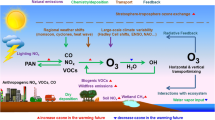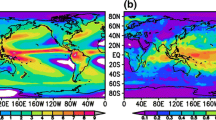Abstract
Characteristics of the thermal tropopause are computed and analyzed on the base of 18-year series (1990–2007) of radio sounding data at Barrow station. The seasonal and interannual variability of tropopause height and temperature values, as well as of the relative humidity and wind speed at this level are investigated. Investigation of the tropopause “contrast” value, which defines the tropopause as the separating layer, is carried out. It is shown that during the period under review the tropopause has become stronger pronounced, mainly due to the temperature lapse rate increase in the lower stratosphere.
Similar content being viewed by others
References
J. S. Bendat and A. Piersol, Random Data: Analysis and Measurement Procedures (Mir, Moscow, 1989) [Transl. from Engl.].
A. R. Ivanova and V. V. Borisova, “Seasonal Variability of Positional Relationship between the Tropopause and the Jet Stream Axis,” Trudy Gidromettsentra Rossii, No. 321 (1992) [Trans. Hydrometeorological Res. Center of Russia, No. 321 (1992)].
Z. M. Makhover, Tropopause Climatology (Gidrometeoizdat, Leningrad, 1983) [in Russian].
N. P. Shakina, The Dynamics of Atmospheric Fronts and Cyclones (Gidrometeoizdat, Leningrad, 1985) [in Russian].
N. P. Shakina and V. V. Borisova, “Experience of Using Potential Vorticity to Calculate the Height of the Tropopause,” Meteorol. Gidrol., No. 5 (1992) [Russ. Meteorol. Hydrol., No. 5 (1992)].
S. Bethan, G. Vaughan, and S. J. Reid, “A Comparison of Ozone and Thermal Tropopause Height and the Impact of Tropopause Definition of Quantifying the Ozone Content of the Troposphere,” Quart. J. Roy. Meteorol. Soc., 126 (1996).
B. D. Cox, M. Bithell, and L. J. Gray, “Modelling of Stratospheric Intrusions within a Mid-latitude Synoptic-scale Disturbance,” Quart. J. Roy. Meteorol. Soc., 123 (1997).
K. P. Hoinka, “Statistics of the Global Tropopause Pressure,” Mon. Wea. Rev., 126 (1998).
J. D. Price and G. Vaughan, “The Potential for Stratosphere-Troposphere Exchange in Cut-off-Low Systems,” Quart. J. Roy. Meteorol. Soc., 119 (1993).
I. Stainer, K. Wargan, S. Pawson, et al., “Assimilated Ozone from EOS-Aura: Evaluation of Tropopause Region and Tropospheric Columns,” J. Geophys. Res., No. D16S32, 113 (2008).
W. Steinbrecht, H. Claude, U. Köhler, and K. P. Hoinka, “Correlations between Tropopause Height and Total Ozone: Implications for Long-term Changes,” J. Geophys. Res., No. 19, 103 (1998).
A. Stohl, P. Bonasoni, P. Cristofanelli, et al., “Stratosphere-Troposphere Exchange. A Review, and What We Have Learned from STACCATO,” J. Geophys. Res., No. D12, 108 (2003).
V. Wirth, “Thermal versus Dynamical Tropopause in Upper Tropospheric Balanced Flow Anomalies,” Quart. J. Roy. Meteorol. Soc., 126 (2000).
“WMO: Definition of the Tropopause,” WMO Bull., No. 6 (1957).
Zangl and K. Hoinka, “Tropopause in the Polar Regions,” J. Climate, 14 (2001).
Author information
Authors and Affiliations
Additional information
Original Russian Text © A.R. Ivanova, 2010, published in Meteorologiya i Gidrologiya, 2010, No.3, pp. 18–27.
About this article
Cite this article
Ivanova, A.R. Investigation of tropopause characteristics in the polar zone with the use of radio sounding data at Barrow station. Russ. Meteorol. Hydrol. 35, 168–174 (2010). https://doi.org/10.3103/S1068373910030027
Received:
Published:
Issue Date:
DOI: https://doi.org/10.3103/S1068373910030027




